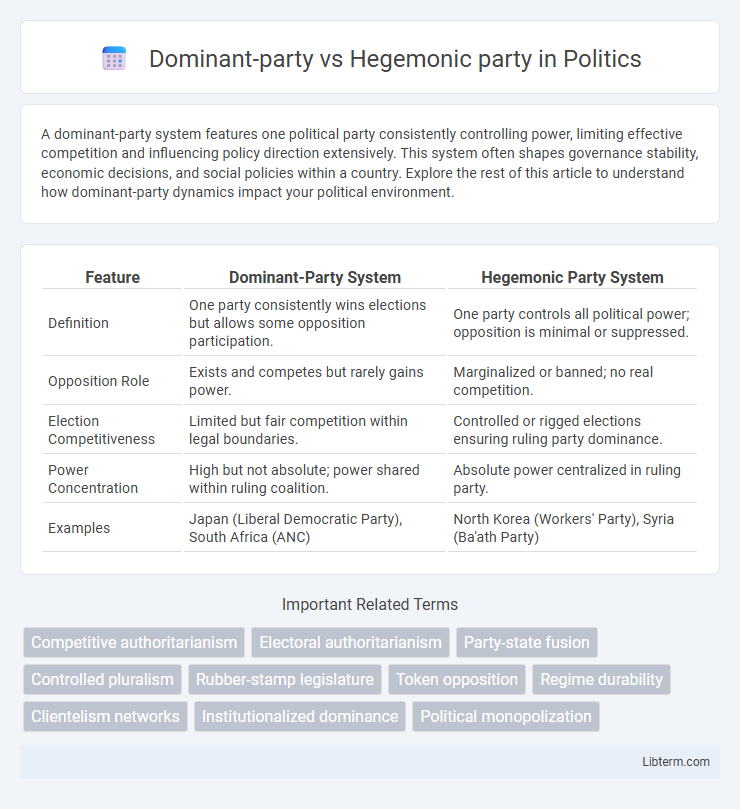A dominant-party system features one political party consistently controlling power, limiting effective competition and influencing policy direction extensively. This system often shapes governance stability, economic decisions, and social policies within a country. Explore the rest of this article to understand how dominant-party dynamics impact your political environment.
Table of Comparison
| Feature | Dominant-Party System | Hegemonic Party System |
|---|---|---|
| Definition | One party consistently wins elections but allows some opposition participation. | One party controls all political power; opposition is minimal or suppressed. |
| Opposition Role | Exists and competes but rarely gains power. | Marginalized or banned; no real competition. |
| Election Competitiveness | Limited but fair competition within legal boundaries. | Controlled or rigged elections ensuring ruling party dominance. |
| Power Concentration | High but not absolute; power shared within ruling coalition. | Absolute power centralized in ruling party. |
| Examples | Japan (Liberal Democratic Party), South Africa (ANC) | North Korea (Workers' Party), Syria (Ba'ath Party) |
Introduction: Defining Dominant-Party and Hegemonic Party Systems
Dominant-party systems feature a single political party that consistently controls government power through regular, competitive elections, allowing opposition parties limited chances of winning. Hegemonic party systems maintain power through a combination of electoral dominance and suppression or co-optation of opposition, often blurring the lines between democratic competition and authoritarian control. Understanding these distinctions highlights the varying mechanisms of party dominance and the impact on political pluralism and governance.
Historical Context: Evolution of Party Systems
Dominant-party systems emerge when a single political party consistently wins elections over extended periods without completely eliminating opposition, often seen in post-colonial states during nation-building phases. Hegemonic party systems represent a more entrenched structure where one party holds near-total control over political, economic, and social institutions, exemplified by the Institutional Revolutionary Party (PRI) in Mexico throughout the 20th century. Both systems reflect distinct historical trajectories shaped by factors such as colonial legacies, revolutionary movements, and institutional consolidation affecting party system evolution globally.
Key Characteristics of Dominant-Party Systems
Dominant-party systems are characterized by the continuous electoral success of a single party that maintains power through legitimate democratic processes, often featuring free but not fully competitive elections. These systems typically exhibit a strong organizational structure, institutional advantages, and widespread voter loyalty, enabling the dominant party to control political resources and suppress effective opposition. Unlike hegemonic party systems, dominant-party systems allow for some level of political pluralism and potential alternation of power, though the dominant party's influence remains pervasive and stable over time.
Core Features of Hegemonic Party Systems
Hegemonic party systems are characterized by a single political party maintaining uninterrupted control over government institutions through centralized authority, extensive state resources, and suppression of opposition. Core features include monopolization of political power, manipulation of electoral processes, and institutionalized dominance that prevents genuine political competition. Unlike dominant-party systems, hegemonic systems often employ formal and informal mechanisms to sustain long-term supremacy and control over both state and society.
Political Competition: Differences in Pluralism
Dominant-party systems allow limited political competition with opposition parties participating but rarely winning significant power, maintaining a facade of pluralism. Hegemonic party systems suppress genuine political competition by monopolizing power and often manipulative electoral processes, resulting in minimal pluralism. The key difference lies in the degree of political openness, where dominant-party systems permit controlled contestation, while hegemonic systems enforce a near-total exclusion of challengers.
Electoral Processes and Party Control
Dominant-party systems feature a single party that consistently wins elections through competitive but skewed electoral processes, maintaining control by blending formal democratic mechanisms with subtle manipulation like media influence and patronage networks. Hegemonic party systems exhibit near-total monopoly over political power, where elections are often non-competitive or heavily rigged, enabling the party to enforce strict control over political institutions and suppress opposition. Electoral processes in hegemonic systems lack genuine pluralism, while dominant-party systems allow for some opposition presence, albeit significantly constrained.
Role of Opposition Parties in Each System
In dominant-party systems, opposition parties exist but face significant barriers such as limited media access and legal constraints, often resulting in weak or token opposition. Hegemonic party systems suppress opposition more effectively through coercion, electoral manipulation, and control over state institutions, rendering opposition parties virtually powerless or irrelevant. The role of opposition in dominant-party systems allows for some political contestation, whereas in hegemonic systems, opposition is systematically marginalized and unable to influence governance or policy decisions.
Impact on Governance and Policy Making
Dominant-party systems often allow for measured policy continuity and stability but may limit political competition, potentially reducing government responsiveness and accountability. Hegemonic party systems concentrate power to an extent that suppresses opposition, leading to governance that favors entrenched elites and risks authoritarianism. Both systems influence policy making by centralizing authority, yet hegemonic parties typically exhibit less transparency and weaker institutional checks compared to dominant parties.
Case Studies: Global Examples of Both Party Types
Dominant-party systems, such as South Africa's African National Congress (ANC), maintain power through regular, competitive elections but face viable opposition, whereas hegemonic parties like Mexico's Institutional Revolutionary Party (PRI) historically controlled political power with minimal effective competition. In India, the BJP exemplifies a dominant party by winning consecutive elections amid active multiparty contests, contrasting with Zimbabwe's ZANU-PF, which operates as a hegemonic party through suppression of opposition and manipulation of electoral mechanisms. These global case studies illustrate how dominant parties uphold democratic frameworks despite long-term rule, while hegemonic parties erode political pluralism and entrench authoritarian governance.
Conclusion: Implications for Democracy and Political Stability
Dominant-party systems consolidate power within one party, allowing limited political competition but often maintaining democratic frameworks, whereas hegemonic parties exert near-total control, severely restricting opposition and undermining democratic principles. The dominance of a single party can ensure political stability through continuity, but hegemonic party control frequently leads to authoritarianism and suppressed civil liberties. Understanding these distinctions is critical for assessing the health of democracy and the prospects for political stability in different governance contexts.
Dominant-party Infographic

 libterm.com
libterm.com